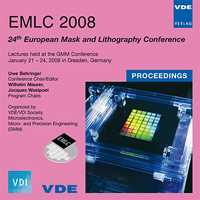Double Exposure Technology for KrF Lithography
Conference: EMLC 2008 - 24th European Mask and Lithography Conference
01/21/2008 - 01/24/2008 at Dresden, Germany
Proceedings: EMLC 2008
Pages: 9Language: englishTyp: PDF
Personal VDE Members are entitled to a 10% discount on this title
Authors:
Geisler, S.; Bauer, J.; Haak, U.; Schulz, K.; Matthus, E.; Marschmeyer, St.; Kuck, B. (IHP, Im Technologiepark 25, 15236 Frankfurt (Oder), Germany)
Stolarek, D.; Beyer, H. (Technische Fachhochschule Wildau, Fachbereich Ingenieurwesen / Wirtschaftsingenieurwesen, Studienrichtung Physikalische Technik, Bahnhofstrasse, D-15754 Wildau)
Wolf, H. (Photronics, Inc., Photronics MZD GmbH, Maria-Reiche-Str.4, D-01109 Dresden)
Meier, W.; Old, G. (Nikon Precision Europe GmbH, Paul-Ehrlich-Str. 3-5, D-63225 Langen, Germany)
Trojahn, M. (Rohm and Haas Electronic Materials Deutschland GmbH, Limburgstr. 31, D-73734 Esslingen)
Abstract:
The application of Double Exposure Lithography (DEL) would enlarge the capability of 248 nm exposure technique to smaller pitch. We will use the DEL for the integration of critical layers for dedicated applications requiring resolution enhancement into 0.13 µm BiCMOS technology. In this paper we present the overlay precision and the focus difference of 1st and 2nd exposure as critical parameters of the DEL for k1 = 0.3 lithography (100 nm half pitch) with binary masks (BIM). The realization of excellent overlay (OVL) accuracy is a main key of double exposure and double patterning techniques. We show the DEL requires primarily a good mask registration, when the wafer stays in the scanner for both exposures without alignment between 1st and 2nd exposure. The exposure tool overlay error is more a practical limit for double patterning lithography (DPL). Hence we prefer the DEL for the resolution enhancement, especially if we use the KrF high NA lithography tool for 130 nm generation. Experimental and simulated results show that the critical dimension uniformity (CDU) depends strongly on the overlay precision. The DEL results show CDU is not only affected by the OVL but also by an optical proximity effect of 1st and 2nd exposure and the mask registration. The CD uniformity of DEL demands a low focus difference between 1st and 2nd exposure and therefore requires a good focus repeatability of the exposure tool. The Depth of Focus (DOF) of 490 nm at stable CD of lines was achieved for DEL. If we change the focus of one of the exposures the CD-focus performance of spaces was reduced with simultaneous line position changing. CDU vs. focus difference between 1st and 2nd exposure demands a focus repeatability <100 nm for the exposure tool. Summary, the results show DEL has the potential to be a practical lithography enhancement method for device fabrication using high NA KrF tool generation.


